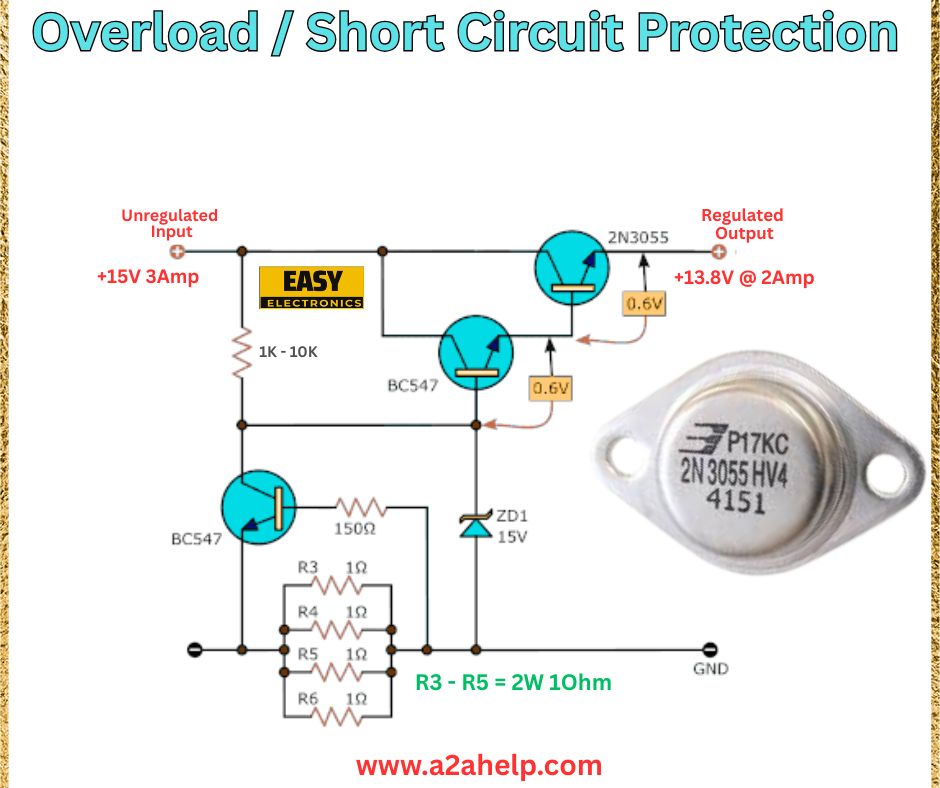Are you working on an electronics project and worried about damaging your components due to overloads or short circuits? Adding overload and short circuit protection to your power supply can save your circuits from costly failures. This DIY guide walks you through building a simple yet effective protection circuit that safeguards your devices with a regulated output of +13.8V at 2A. Perfect for hobbyists and professionals alike, this project uses readily available components to ensure reliability.
What is Overload and Short Circuit Protection?
Overload and short circuit protection is a critical feature in power supply designs that prevents damage from excessive current or unintended connections. This circuit monitors the current flow and shuts down the output if it exceeds safe limits, protecting both the power supply and connected devices. Operating with a +15V 3A unregulated input, it delivers a stable +13.8V output at 2A, making it ideal for various electronic applications.
Key Components
- BC547 Transistors: NPN transistors for current sensing and control.
- 2N3055 Transistor: High-power NPN transistor for output regulation.
- Zener Diode (ZDI): 15V Zener diode for voltage reference.
- Resistors: 1kΩ-10kΩ (variable), 150Ω, and six 1Ω resistors (R3-R6) rated at 2W each.
- Input: +15V 3A unregulated supply.
- Output: Regulated +13.8V at 2A.
Step-by-Step Guide to Building the Protection Circuit

1. Gather Your Materials
Collect all necessary components and tools, including a soldering iron, PCB or perf board, multimeter, and a +15V 3A power source. High-quality parts from suppliers like Easy Electronics ensure optimal performance and durability.
2. Assemble the Circuit
Follow the schematic diagram carefully:
- Connect the +15V unregulated input to a 1kΩ-10kΩ variable resistor, then to the base of the first BC547 transistor.
- Link the emitter of the first BC547 to the base of the second BC547 via a 150Ω resistor.
- Attach four 1Ω resistors (R3-R6) in parallel between the emitter of the second BC547 and ground, forming a current sense network (total 0.25Ω, 2W).
- Connect the collector of the second BC547 to the base of the 2N3055 transistor.
- Place a 15V Zener diode (ZDI) between the base of the 2N3055 and ground to regulate voltage.
- Link the collector of the 2N3055 to the +15V input and the emitter to the output (+13.8V at 2A).
- Ground all emitter connections properly.
3. Test the Circuit
Before connecting your load, test the circuit with a multimeter. Adjust the 1kΩ-10kΩ resistor to set the output to +13.8V. Apply a load and monitor the current; the circuit should limit output if it exceeds 2A or detects a short.
4. Install Heat Sinks
The 2N3055 transistor will generate heat under load. Attach a heat sink to prevent overheating and ensure long-term reliability.
5. Final Adjustments
Verify the protection mechanism by intentionally creating a short circuit. The output should drop, protecting the circuit. Fine-tune resistor values if needed for your specific application.
Benefits of Overload and Short Circuit Protection
- Component Safety: Prevents damage from current spikes or shorts.
- Reliability: Ensures stable +13.8V output at 2A.
- Cost-Effective: Uses affordable, common components.
- Versatile: Suitable for various power supply projects.
Troubleshooting Common Issues
- No Output: Check the input voltage and ensure proper transistor connections.
- Overheating: Verify the heat sink and reduce load if necessary.
- Protection Not Triggering: Adjust the 1Ω resistors or check the Zener diode.
Safety Tips
- Disconnect the power supply during assembly to avoid electrical shocks.
- Use insulated tools and wear protective gear.
- Test with a low load initially to confirm functionality.
Conclusion
Building an overload and short circuit protection circuit is a valuable skill that enhances the safety and longevity of your electronics projects. By following this guide and using the schematic from a2ahelp.com, you can create a robust protection system for your +13.8V 2A power supply. Explore more DIY electronics tutorials on our site and subscribe for the latest updates!
